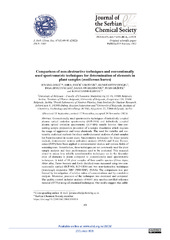Приказ основних података о документу
Comparison of non-destructive techniques and conventionally used spectrometric techniques for determination of elements in plant samples (coniferous leaves)
| dc.creator | Orlić, Jovana | |
| dc.creator | Aničić-Urošević, Mira | |
| dc.creator | Vergel, Konstantin | |
| dc.creator | Zinicovscaia, Inga | |
| dc.creator | Stojadinović, Sanja M. | |
| dc.creator | Gržetić, Ivan | |
| dc.creator | Ilijević, Konstantin | |
| dc.date.accessioned | 2022-04-25T16:13:55Z | |
| dc.date.available | 2022-04-25T16:13:55Z | |
| dc.date.issued | 2022 | |
| dc.identifier.issn | 0352-5139 | |
| dc.identifier.uri | http://cherry.chem.bg.ac.rs/handle/123456789/5007 | |
| dc.description.abstract | Conventionally used spectrometric techniques of inductively coupled plasma optical emission spectrometry (ICP-OES) and inductively coupled plasma optical emission spectrometry (ICP-MS) usually involve time-consuming sample preparation procedure of a sample dissolution which requires the usage of aggressive and toxic chemicals. The need for suitable and sustainable analytical methods for direct multi-elemental analysis of plant samples has been increased in recent years. Spectrometric techniques for direct sample analysis, instrumental neutron activation analysis (INAA) and X-ray fluorescence (XRF) have been applied in environmental studies and various fields of screening tests. Nevertheless, these techniques are not commonly used for plant sample analysis and their performances need to be evaluated. This research aimed to assess how reliable non-destructive techniques are in the determination of elements in plants compared to conventionally used spectrometric techniques. A total of 49 plant samples of four conifer species (Pinus nigra, Abies alba, Taxus baccata and Larix decidua) were measured using two conventionally applied (ICP-MS, ICP-OES) and two non-destructive techniques (wavelength dispersive XRF (WD-XRF), INAA). The comparison was performed by investigation of relative ratios of concentrations and by correlation analysis. Moreover, precision of the techniques was examined and compared. The quality control included analysis of NIST pine needles certified reference material (1575a) using all examined techniques. Our results suggest that additional analytical and quality control steps are necessary for reaching the highest accuracy of multi-elemental analysis. | |
| dc.relation | info:eu-repo/grantAgreement/MESTD/inst-2020/200168/RS// | |
| dc.relation | info:eu-repo/grantAgreement/MESTD/inst-2020/200026/RS// | |
| dc.rights | openAccess | |
| dc.rights.uri | https://creativecommons.org/licenses/by-nc-nd/4.0/ | |
| dc.source | Journal of the Serbian Chemical Society | |
| dc.subject | multi-element determination | |
| dc.subject | WD-XRF | |
| dc.subject | standardless analysis | |
| dc.subject | INAA | |
| dc.subject | ICP-OES | |
| dc.subject | ICP-MS | |
| dc.title | Comparison of non-destructive techniques and conventionally used spectrometric techniques for determination of elements in plant samples (coniferous leaves) | |
| dc.type | article | en |
| dc.rights.license | BY-NC-ND | |
| dc.citation.volume | 87 | |
| dc.citation.issue | 1 | |
| dc.citation.spage | 69 | |
| dc.citation.epage | 81 | |
| dc.identifier.wos | 000768809100007 | |
| dc.identifier.doi | 10.2298/JSC210921101O | |
| dc.citation.rank | M23~ | |
| dc.type.version | publishedVersion | |
| dc.identifier.scopus | 2-s2.0-85124474681 | |
| dc.identifier.fulltext | http://cherry.chem.bg.ac.rs/bitstream/id/29353/Comparison_of_non_pub_2022.pdf |


